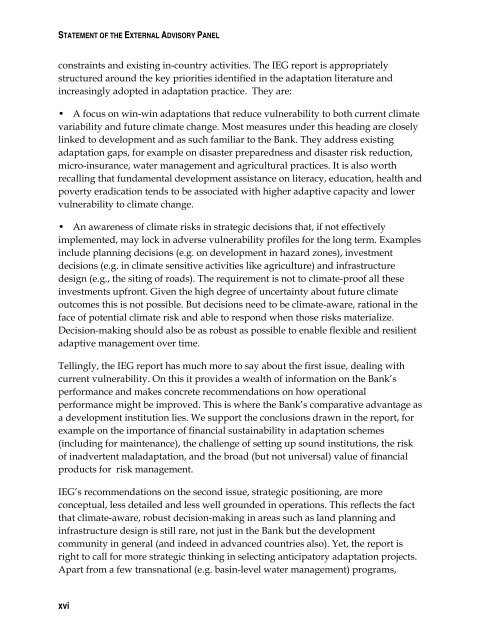Adapting to Climate Change: Assessing the World Bank Group ...
Adapting to Climate Change: Assessing the World Bank Group ...
Adapting to Climate Change: Assessing the World Bank Group ...
Create successful ePaper yourself
Turn your PDF publications into a flip-book with our unique Google optimized e-Paper software.
STATEMENT OF THE EXTERNAL ADVISORY PANELconstraints and existing in-country activities. The IEG report is appropriatelystructured around <strong>the</strong> key priorities identified in <strong>the</strong> adaptation literature andincreasingly adopted in adaptation practice. They are:• A focus on win-win adaptations that reduce vulnerability <strong>to</strong> both current climatevariability and future climate change. Most measures under this heading are closelylinked <strong>to</strong> development and as such familiar <strong>to</strong> <strong>the</strong> <strong>Bank</strong>. They address existingadaptation gaps, for example on disaster preparedness and disaster risk reduction,micro-insurance, water management and agricultural practices. It is also worthrecalling that fundamental development assistance on literacy, education, health andpoverty eradication tends <strong>to</strong> be associated with higher adaptive capacity and lowervulnerability <strong>to</strong> climate change.• An awareness of climate risks in strategic decisions that, if not effectivelyimplemented, may lock in adverse vulnerability profiles for <strong>the</strong> long term. Examplesinclude planning decisions (e.g. on development in hazard zones), investmentdecisions (e.g. in climate sensitive activities like agriculture) and infrastructuredesign (e.g., <strong>the</strong> siting of roads). The requirement is not <strong>to</strong> climate-proof all <strong>the</strong>seinvestments upfront. Given <strong>the</strong> high degree of uncertainty about future climateoutcomes this is not possible. But decisions need <strong>to</strong> be climate-aware, rational in <strong>the</strong>face of potential climate risk and able <strong>to</strong> respond when those risks materialize.Decision-making should also be as robust as possible <strong>to</strong> enable flexible and resilientadaptive management over time.Tellingly, <strong>the</strong> IEG report has much more <strong>to</strong> say about <strong>the</strong> first issue, dealing withcurrent vulnerability. On this it provides a wealth of information on <strong>the</strong> <strong>Bank</strong>’sperformance and makes concrete recommendations on how operationalperformance might be improved. This is where <strong>the</strong> <strong>Bank</strong>’s comparative advantage asa development institution lies. We support <strong>the</strong> conclusions drawn in <strong>the</strong> report, forexample on <strong>the</strong> importance of financial sustainability in adaptation schemes(including for maintenance), <strong>the</strong> challenge of setting up sound institutions, <strong>the</strong> riskof inadvertent maladaptation, and <strong>the</strong> broad (but not universal) value of financialproducts for risk management.IEG’s recommendations on <strong>the</strong> second issue, strategic positioning, are moreconceptual, less detailed and less well grounded in operations. This reflects <strong>the</strong> factthat climate-aware, robust decision-making in areas such as land planning andinfrastructure design is still rare, not just in <strong>the</strong> <strong>Bank</strong> but <strong>the</strong> developmentcommunity in general (and indeed in advanced countries also). Yet, <strong>the</strong> report isright <strong>to</strong> call for more strategic thinking in selecting anticipa<strong>to</strong>ry adaptation projects.Apart from a few transnational (e.g. basin-level water management) programs,xvi

















